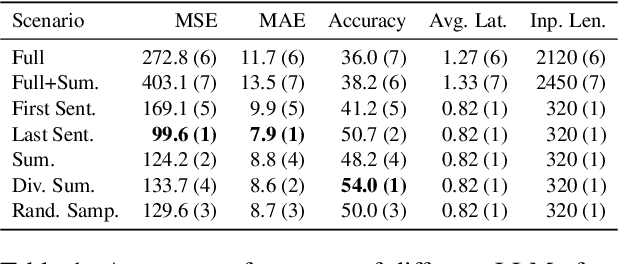Matthew Purver
Queen Mary University of London
Recent Trends in Linear Text Segmentation: a Survey
Nov 25, 2024Abstract:Linear Text Segmentation is the task of automatically tagging text documents with topic shifts, i.e. the places in the text where the topics change. A well-established area of research in Natural Language Processing, drawing from well-understood concepts in linguistic and computational linguistic research, the field has recently seen a lot of interest as a result of the surge of text, video, and audio available on the web, which in turn require ways of summarising and categorizing the mole of content for which linear text segmentation is a fundamental step. In this survey, we provide an extensive overview of current advances in linear text segmentation, describing the state of the art in terms of resources and approaches for the task. Finally, we highlight the limitations of available resources and of the task itself, while indicating ways forward based on the most recent literature and under-explored research directions.
Evaluating and explaining training strategies for zero-shot cross-lingual news sentiment analysis
Sep 30, 2024



Abstract:We investigate zero-shot cross-lingual news sentiment detection, aiming to develop robust sentiment classifiers that can be deployed across multiple languages without target-language training data. We introduce novel evaluation datasets in several less-resourced languages, and experiment with a range of approaches including the use of machine translation; in-context learning with large language models; and various intermediate training regimes including a novel task objective, POA, that leverages paragraph-level information. Our results demonstrate significant improvements over the state of the art, with in-context learning generally giving the best performance, but with the novel POA approach giving a competitive alternative with much lower computational overhead. We also show that language similarity is not in itself sufficient for predicting the success of cross-lingual transfer, but that similarity in semantic content and structure can be equally important.
ClarQ-LLM: A Benchmark for Models Clarifying and Requesting Information in Task-Oriented Dialog
Sep 09, 2024Abstract:We introduce ClarQ-LLM, an evaluation framework consisting of bilingual English-Chinese conversation tasks, conversational agents and evaluation metrics, designed to serve as a strong benchmark for assessing agents' ability to ask clarification questions in task-oriented dialogues. The benchmark includes 31 different task types, each with 10 unique dialogue scenarios between information seeker and provider agents. The scenarios require the seeker to ask questions to resolve uncertainty and gather necessary information to complete tasks. Unlike traditional benchmarks that evaluate agents based on fixed dialogue content, ClarQ-LLM includes a provider conversational agent to replicate the original human provider in the benchmark. This allows both current and future seeker agents to test their ability to complete information gathering tasks through dialogue by directly interacting with our provider agent. In tests, LLAMA3.1 405B seeker agent managed a maximum success rate of only 60.05\%, showing that ClarQ-LLM presents a strong challenge for future research.
Efficient Solutions For An Intriguing Failure of LLMs: Long Context Window Does Not Mean LLMs Can Analyze Long Sequences Flawlessly
Aug 03, 2024



Abstract:Large Language Models (LLMs) have demonstrated remarkable capabilities in comprehending and analyzing lengthy sequential inputs, owing to their extensive context windows that allow processing millions of tokens in a single forward pass. However, this paper uncovers a surprising limitation: LLMs fall short when handling long input sequences. We investigate this issue using three datasets and two tasks (sentiment analysis and news categorization) across various LLMs, including Claude 3, Gemini Pro, GPT 3.5 Turbo, Llama 3 Instruct, and Mistral Instruct models. To address this limitation, we propose and evaluate ad-hoc solutions that substantially enhance LLMs' performance on long input sequences by up to 50%, while reducing API cost and latency by up to 93% and 50%, respectively.
Multimodal Machine Learning in Mental Health: A Survey of Data, Algorithms, and Challenges
Jul 23, 2024Abstract:The application of machine learning (ML) in detecting, diagnosing, and treating mental health disorders is garnering increasing attention. Traditionally, research has focused on single modalities, such as text from clinical notes, audio from speech samples, or video of interaction patterns. Recently, multimodal ML, which combines information from multiple modalities, has demonstrated significant promise in offering novel insights into human behavior patterns and recognizing mental health symptoms and risk factors. Despite its potential, multimodal ML in mental health remains an emerging field, facing several complex challenges before practical applications can be effectively developed. This survey provides a comprehensive overview of the data availability and current state-of-the-art multimodal ML applications for mental health. It discusses key challenges that must be addressed to advance the field. The insights from this survey aim to deepen the understanding of the potential and limitations of multimodal ML in mental health, guiding future research and development in this evolving domain.
EquiPrompt: Debiasing Diffusion Models via Iterative Bootstrapping in Chain of Thoughts
Jun 13, 2024Abstract:In the domain of text-to-image generative models, the inadvertent propagation of biases inherent in training datasets poses significant ethical challenges, particularly in the generation of socially sensitive content. This paper introduces EquiPrompt, a novel method employing Chain of Thought (CoT) reasoning to reduce biases in text-to-image generative models. EquiPrompt uses iterative bootstrapping and bias-aware exemplar selection to balance creativity and ethical responsibility. It integrates iterative reasoning refinement with controlled evaluation techniques, addressing zero-shot CoT issues in sensitive contexts. Experiments on several generation tasks show EquiPrompt effectively lowers bias while maintaining generative quality, advancing ethical AI and socially responsible creative processes.Code will be publically available.
A Computational Analysis of the Dehumanisation of Migrants from Syria and Ukraine in Slovene News Media
Apr 10, 2024

Abstract:Dehumanisation involves the perception and or treatment of a social group's members as less than human. This phenomenon is rarely addressed with computational linguistic techniques. We adapt a recently proposed approach for English, making it easier to transfer to other languages and to evaluate, introducing a new sentiment resource, the use of zero-shot cross-lingual valence and arousal detection, and a new method for statistical significance testing. We then apply it to study attitudes to migration expressed in Slovene newspapers, to examine changes in the Slovene discourse on migration between the 2015-16 migration crisis following the war in Syria and the 2022-23 period following the war in Ukraine. We find that while this discourse became more negative and more intense over time, it is less dehumanising when specifically addressing Ukrainian migrants compared to others.
Reformulating NLP tasks to Capture Longitudinal Manifestation of Language Disorders in People with Dementia
Oct 15, 2023Abstract:Dementia is associated with language disorders which impede communication. Here, we automatically learn linguistic disorder patterns by making use of a moderately-sized pre-trained language model and forcing it to focus on reformulated natural language processing (NLP) tasks and associated linguistic patterns. Our experiments show that NLP tasks that encapsulate contextual information and enhance the gradient signal with linguistic patterns benefit performance. We then use the probability estimates from the best model to construct digital linguistic markers measuring the overall quality in communication and the intensity of a variety of language disorders. We investigate how the digital markers characterize dementia speech from a longitudinal perspective. We find that our proposed communication marker is able to robustly and reliably characterize the language of people with dementia, outperforming existing linguistic approaches; and shows external validity via significant correlation with clinical markers of behaviour. Finally, our proposed linguistic disorder markers provide useful insights into gradual language impairment associated with disease progression.
Lon-eå at SemEval-2023 Task 11: A Comparison of\\Activation Functions for Soft and Hard Label Prediction
Mar 04, 2023Abstract:We study the influence of different activation functions in the output layer of deep neural network models for soft and hard label prediction in the learning with disagreement task. In this task, the goal is to quantify the amount of disagreement via predicting soft labels. To predict the soft labels, we use BERT-based preprocessors and encoders and vary the activation function used in the output layer, while keeping other parameters constant. The soft labels are then used for the hard label prediction. The activation functions considered are sigmoid as well as a step-function that is added to the model post-training and a sinusoidal activation function, which is introduced for the first time in this paper.
CoRAL: a Context-aware Croatian Abusive Language Dataset
Nov 11, 2022Abstract:In light of unprecedented increases in the popularity of the internet and social media, comment moderation has never been a more relevant task. Semi-automated comment moderation systems greatly aid human moderators by either automatically classifying the examples or allowing the moderators to prioritize which comments to consider first. However, the concept of inappropriate content is often subjective, and such content can be conveyed in many subtle and indirect ways. In this work, we propose CoRAL -- a language and culturally aware Croatian Abusive dataset covering phenomena of implicitness and reliance on local and global context. We show experimentally that current models degrade when comments are not explicit and further degrade when language skill and context knowledge are required to interpret the comment.
 Add to Chrome
Add to Chrome Add to Firefox
Add to Firefox Add to Edge
Add to Edge